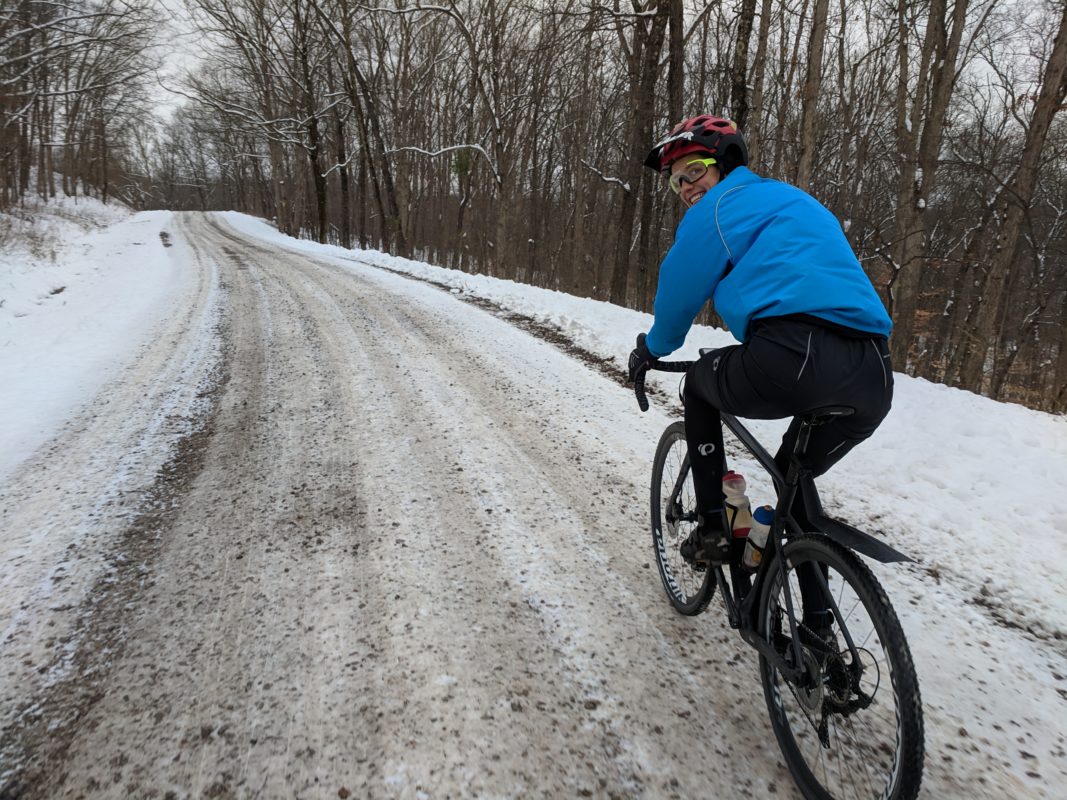
Last winter, we did the vast majority of our training outside…in Ohio. It was cold and wet, but NOT MISERABLE, because we know and practice these basic tenets of dressing for winter weather.
1. There is no bad weather, only bad clothes.
Riding outside is always more fun than riding inside on a trainer, as long as you’re dressed appropriately and adopt the right attitude. No matter the weather, the clothes exist for it. Just look at Antarctic Explorers or Syd’s dad, who commuted by bicycle to work every day for nearly forty years (ice storms and hurricanes not-with-standing). A big part of enjoying winter riding is *thinking* you’re going to enjoy it. Go into with the attitude of “isn’t this awesome, we get to ride in the snow!” not “ugh this is going to be cold.” And, obviously, pick the right clothes.
2. Cotton kills.
While soft organic cotton can be lovely for everyday use, cotton is not a performance fabric and there is no time you need a performance fabric more than when you’re riding in arctic temperatures. Cotton gets heavy and cold when it’s wet, while synthetics stay drier by wicking moisture away from your body. Synthetics are great for summer riding and they’re *okay* for winter riding, but on a cold day, WOOL IS KING. You want the layer closest to your body to be wool, as wool keeps warmth even when it’s wet (if you get sweaty).
Here are some examples of the Merino wool gear we use.
PEARL iZUMi Pro Merino Thermal Jersey: Women’s / Men’s
PEARL iZUMi Merino Thermal LS baselayer: Women’s / Men’s
3. LAYER LAYER LAYER.
Layers allow you to adjust your body temperature as the weather or terrain changes. For example, you might choose to start with a lightweight windbreaker and take it off before you begin your serious workout. Depending on the temperature we will use a light windbreaker or a heavier thermal jacket like this PEARL iZUMi Interval Amfib jacket as our outermost layer.
4. Stay dry.
This applies to both outer layers that are waterproof and wearing smart base layers (like wool or synthetic NOT COTTON) to minimize sweating. Waterproof pants or baggie shorts are an absolute must for winter riding, as is a fully waterproof rain jacket. Nothing is worse than being wet, except being COLD and wet. And nothing is worse than that, except being cold and wet and having WET FEET. If you can swing it, waterproof shoes are a game changer.
Our wet weather gear:
PEARL iZUMi WxB pants
Shimano SH-MW701 shoes
Osprey rain cover
PEARL iZUMi Elite Escape Barrier Jacket
PEARL iZUMi Summit WxB Jacket
5. Protect your hands and feet (and head).
It’s an old wives’ tale that warmth leaves via your head; in fact warmth leaves your body anywhere that is uncovered! But since fitting a hat under a helmet can be difficult, many of us forego a hat while riding, to our detriment. It’s equally important to keep your hands and feet warm (see earlier point about waterproof shoes!). For mountain bikers, it’s especially worth investing in a decent pair of gloves that feel normal while you’re riding your bike. It’s not necessary to sacrifice dexterity and control for warmth! For your feet, waterproof shoes plus a decent pair of thermal merino wool socks will see you through the most inclement weather.
Here are a few examples of what we use to keep hands and head warm.
PEARL iZUMi Thermal balaclava
PEARL iZUMi Thermal skull cap
PEARL iZUMi P.R.O Softshell Lite glove
For more discussion, watch our video on the topic!
*This video was sponsored by Competitive Cyclist and this post contains affiliate links*

